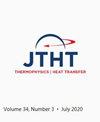火箭喷管烧蚀传热模型的不确定性
IF 1.7
4区 工程技术
Q4 ENGINEERING, MECHANICAL
引用次数: 0
摘要
固体火箭发动机(SRM)喷管中碳布酚醛绝缘子的烧蚀是一个非常复杂的现象,难以准确预测。历史上甚至更现代的烧蚀预测在很大程度上依赖于锚定SRM测试数据,以提高可预测性和SRM可靠性。加速的进度,飞行前静态SRM测试的减少,以及高度竞争的全球市场,都对计算能力和预测不确定性造成了重大影响。量化SRM喷嘴烧蚀预测的不确定性对电机可靠性至关重要。本文详细介绍了一种应用于SRM喷嘴环境下碳布酚醛绝缘子烧蚀预测的现代不确定性量化方法。一个特殊的历史测试电机被用作演示案例。我们感兴趣的系统响应量是侵蚀深度和焦化深度。给出了具有代表性的模型和输入不确定性,并进行了灵敏度分析以识别影响参数。数值模型和输入中的不确定性通过使用拉丁超立方体采样方法的二维不确定性量化方法传播。结果表明,SRM喷嘴热模拟的主要不确定性来源是传热系数、入射辐射热流密度、焦炭材料导热系数、原始材料密度、焦炭材料密度、焦炭材料比热和热解气体焓。测试用例的喷嘴绝缘侵蚀和焦化预测的不确定性是相对于喷嘴位置在第99百分位和第95个置信区间提供的。沿喷嘴的整个轴向长度,焦炭深度的不确定性大致为[公式:见文本]。侵蚀深度的不确定性范围从入口和喉部的[公式:见文]到喷嘴出口处的[公式:见文]不等。本文章由计算机程序翻译,如有差异,请以英文原文为准。
Uncertainty in Modeling Ablation Heat Transfer in Rocket Nozzles
The ablation of carbon cloth phenolic insulators used in solid rocket motor (SRM) nozzles involves highly complex phenomena that are difficult to accurately predict. Historical and even more modern ablation predictions rely heavily on anchoring to SRM test data to improve predictability and SRM reliability. Accelerated schedules, reductions in static SRM testing prior to flight, and a highly competitive global market are placing a substantial onus on computational capability and predictive uncertainty. Quantifying uncertainty in SRM nozzle ablation predictions is essential for motor reliability. This paper provides the details of a modern uncertainty quantification methodology applied to ablation predictions in carbon cloth phenolic insulators exposed to SRM nozzle environments. A particular historical test motor is used as a demonstration case. The system response quantities of interest are the erosion depth and char depth. A representative model and input uncertainty are provided, and a sensitivity analysis is performed to identify influential parameters. Uncertainties in the numerical models and inputs are propagated through a two-dimensional uncertainty quantification methodology using a Latin Hypercube Sampling approach. The results show that the primary sources of uncertainty in SRM nozzle thermal modeling are the heat transfer coefficient, incident radiation heat flux, char material thermal conductivity, virgin material density, char material density, char material specific heat, and pyrolysis gas enthalpy. Uncertainties in the predictions of nozzle insulation erosion and char for the test case are provided relative to the nozzle location at the 99 th percentile and 95th confidence interval. Uncertainty in the char depth is roughly [Formula: see text] along the entire axial length of the nozzle. Uncertainty in the erosion depth ranges from about [Formula: see text] for the entrance and throat regions to [Formula: see text] at the nozzle exit.
求助全文
通过发布文献求助,成功后即可免费获取论文全文。
去求助
来源期刊

Journal of Thermophysics and Heat Transfer
工程技术-工程:机械
CiteScore
3.50
自引率
19.00%
发文量
95
审稿时长
3 months
期刊介绍:
This Journal is devoted to the advancement of the science and technology of thermophysics and heat transfer through the dissemination of original research papers disclosing new technical knowledge and exploratory developments and applications based on new knowledge. The Journal publishes qualified papers that deal with the properties and mechanisms involved in thermal energy transfer and storage in gases, liquids, and solids or combinations thereof. These studies include aerothermodynamics; conductive, convective, radiative, and multiphase modes of heat transfer; micro- and nano-scale heat transfer; nonintrusive diagnostics; numerical and experimental techniques; plasma excitation and flow interactions; thermal systems; and thermophysical properties. Papers that review recent research developments in any of the prior topics are also solicited.
 求助内容:
求助内容: 应助结果提醒方式:
应助结果提醒方式:


